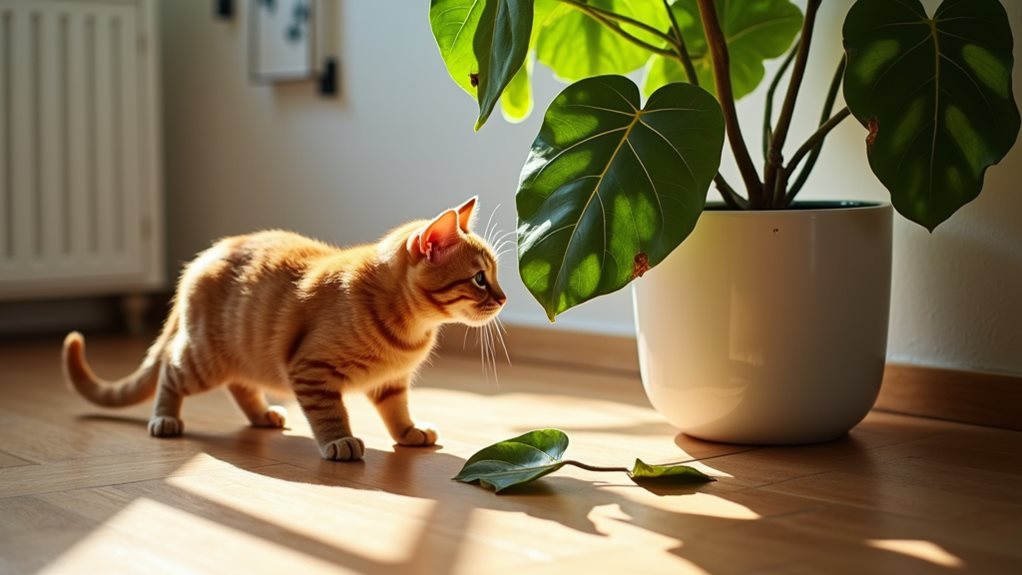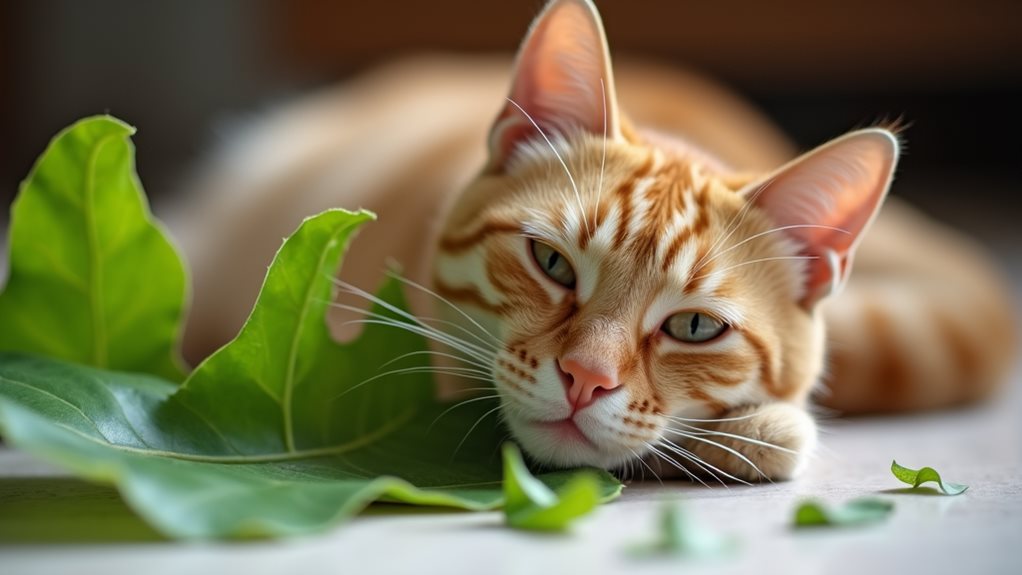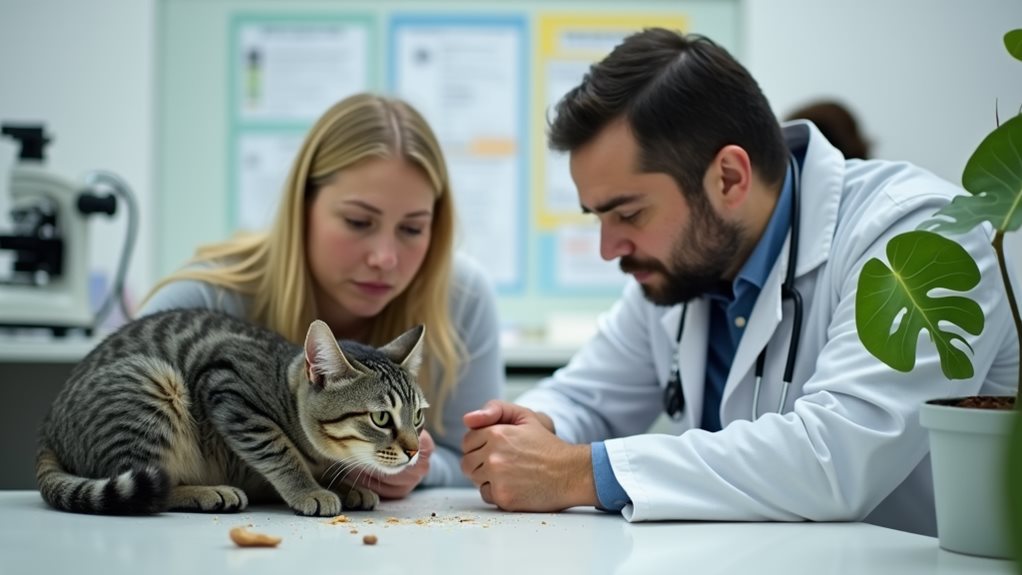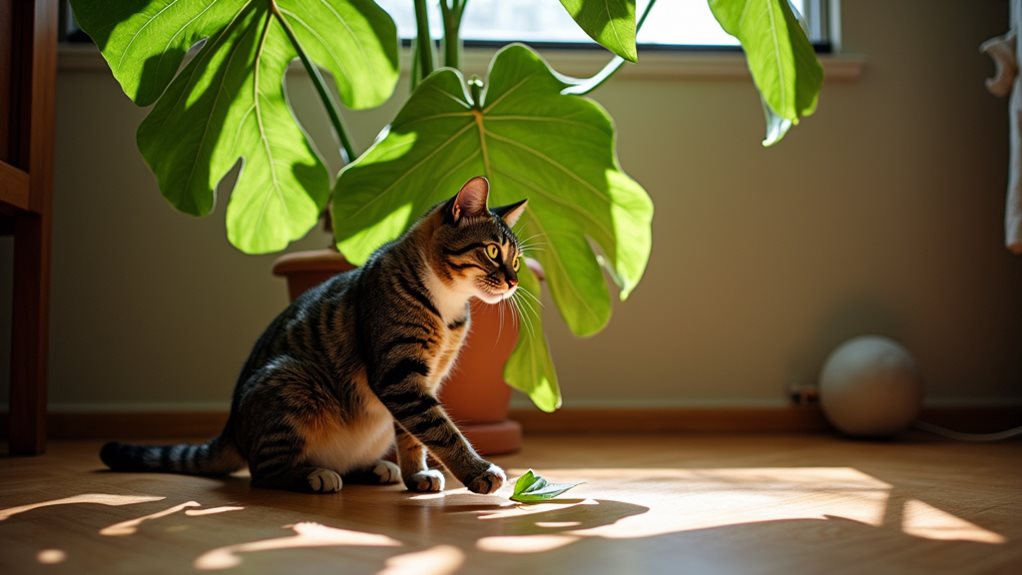Yes, Fiddle Leaf Figs are toxic to cats due to their calcium oxalate crystals and compounds like ficin and psoralen. If your cat chews on any part of the plant, they'll experience immediate burning sensations, drooling, and potential swelling in their mouth and throat. The plant's toxic effects can cause severe gastrointestinal distress, including vomiting and difficulty swallowing. Contact your vet immediately if you notice symptoms like excessive drooling, pawing at the mouth, or respiratory issues. While treatment options exist, prevention is essential – keep these plants out of your cat's reach. Understanding the specific risks and safety measures will help you protect your feline companion.
TLDR
- Fiddle Leaf Fig is toxic to cats due to calcium oxalate crystals, which cause immediate oral irritation and burning sensations.
- Symptoms of poisoning include drooling, vomiting, difficulty swallowing, and possible respiratory distress requiring urgent veterinary care.
- All parts of the plant contain harmful compounds including ficin and psoralen, making the entire plant dangerous for cats.
- Exposure can lead to both immediate reactions like facial swelling and long-term complications affecting kidneys and liver if untreated.
- Keep Fiddle Leaf Figs in areas cats cannot access and use deterrent sprays to prevent potential poisoning incidents.
Understanding Fiddle Leaf Fig Toxicity

Inside the Fiddle Leaf Fig, toxic calcium oxalate crystals pose a significant health risk to cats.
When your cat chews or bites the plant, these crystals can cause immediate burning sensations in their mouth and digestive tract, leading to drooling, vomiting, and difficulty swallowing. Improper watering can stress the plant, potentially increasing the likelihood of leaf damage and toxic crystal release.
You'll notice your cat pawing at their mouth or face, and in severe cases, they might experience dangerous swelling of their upper airway.
Keeping your cat safe requires placing fiddle leaf figs in inaccessible rooms like bathrooms.
Toxic Compounds in the Plant
The toxic compounds in Fiddle Leaf Figs work together to create a dangerous cocktail for cats.
You'll find ficin and psoralen in the leaves and stems, while sapogenin lurks in the milky sap. The plant's most concerning components are calcium oxalate crystals, which are present throughout and can cause severe irritation when your cat chews or ingests any part of the plant. These compounds can affect your cat's health with symptoms ranging from oral irritation and drooling to more severe reactions. Ingesting the plant can lead to gastrointestinal distress, which may require veterinary attention.
Warning Signs of Poisoning

If your cat has come into contact with a fiddle leaf fig plant, you'll need to watch for immediate physical reactions like drooling, facial swelling, and respiratory distress.
The presence of calcium oxalate crystals in all parts of the plant causes immediate tissue irritation upon contact. Additionally, ingestion of other toxic plants, such as chocolate for goats, can lead to similar distressing symptoms in pets.
Critical behavioral changes include excessive pawing at the mouth, loss of appetite, and unusual lip smacking, which can indicate your cat is experiencing discomfort.
Advanced warning signs that require immediate veterinary attention include severe gastrointestinal issues, difficulty breathing, and any signs of facial or throat swelling that could lead to dangerous airway obstruction.
Immediate Physical Reactions
Warning signs of fiddle leaf fig poisoning in cats typically appear within minutes to hours of exposure.
The toxic compounds known as ficin and psoralen found in fiddle leaf figs can quickly trigger poisoning symptoms.
Your cat may show oral irritation through drooling, pawing at their mouth, or foaming.
Watch for gastrointestinal symptoms like vomiting and diarrhea, along with respiratory issues including difficulty breathing and facial swelling.
Skin problems, such as rashes or sores, can also develop.
Behavioral Changes to Watch
Watch for four key behavioral changes that indicate fiddle leaf fig poisoning in cats.
You'll notice significant changes in eating habits, including reduced appetite and food avoidance.
Your cat may become excessively lethargic, sleeping more and playing less.
Look for unusual grooming behaviors, especially around the mouth, with increased drooling or pawing.
Finally, observe for shifts in mood, increased anxiety, and tendency to hide.
Late-Stage Warning Indicators
Recognizing late-stage warning signs of fiddle leaf fig poisoning could mean the difference between life and death for your cat.
Watch for severe respiratory complications, including labored breathing and blue-tinged gums, alongside persistent gastrointestinal distress.
You'll notice your cat becoming lethargic, potentially developing skin rashes, and showing organ damage symptoms.
If you observe these indicators, seek emergency veterinary care immediately.
Health Dangers for Cats
When your cat ingests fiddle leaf fig, you'll notice immediate physical symptoms like excessive drooling, pawing at the mouth, and difficulty swallowing due to the plant's calcium oxalate crystals.
Your cat's gastrointestinal system will likely react with vomiting and diarrhea, while respiratory distress may occur from upper airway swelling. Additionally, exposure to certain toxic houseplants can lead to severe health issues for pets.
Without prompt treatment, your cat could face serious long-term complications, including potential damage to essential organs like the kidneys and liver.
Immediate Physical Effects
Cats who ingest or come into contact with fiddle leaf fig plants face several immediate and severe health risks.
You'll notice rapid physical reactions, including excessive drooling, mouth swelling, and sudden vomiting. The plant's calcium oxalate crystals can cause painful oral irritation, leading to difficulty breathing and intense discomfort.
Your cat may also experience severe skin reactions if they touch the plant's toxic sap.
Long-Term Organ Damage
Beyond the immediate physical symptoms, fiddle leaf fig poisoning can inflict serious damage to your cat's essential organs.
The toxic compounds primarily affect the kidneys and liver, potentially leading to long-term complications if not treated promptly.
You'll need to watch for warning signs like changes in urination patterns, persistent lethargy, or extended periods of vomiting, as these may indicate developing organ damage.
Getting Professional Medical Help

Professional medical intervention is vital if your cat shows signs of fiddle leaf fig poisoning.
Contact the ASPCA's poison control hotline at (888)426-4435 or your veterinarian immediately. When seeking help, provide essential details about when your cat ingested the plant and what symptoms you've observed.
Document any changes in behavior, breathing difficulties, or excessive drooling to help your vet determine the best treatment approach.
Treatment Options
Once your veterinarian has assessed your cat's condition, several treatment options can help address fiddle leaf fig poisoning.
Treatment usually includes flushing your cat's mouth with distilled water, providing fluids to combat dehydration, and administering medications like sucralfate to protect the stomach.
Your vet might also use activated charcoal to prevent toxin absorption and monitor your pet's gastrointestinal symptoms throughout recovery.
Keeping Your Cat Safe

Taking proactive steps to protect your cat from fiddle leaf fig exposure is essential for their safety.
Place your plants on raised surfaces or behind barriers, and consider using cat-safe deterrent sprays around the area.
You'll also want to provide engaging alternatives like scratching posts and toys to redirect your cat's attention, while ensuring all family members understand the plant's toxic nature.
Creating a Pet-Friendly Home
Creating a pet-friendly home while maintaining style and safety requires thoughtful design choices.
Select durable, washable fabrics for furniture and use stylish slipcovers that can withstand pet activity.
Integrate dedicated spaces for feeding and rest by incorporating custom-built storage solutions and designer pet beds.
Keep potentially harmful items out of reach, and organize pet essentials in designated areas that complement your decor.
And Finally
To protect your cat from fiddle leaf fig toxicity, you'll need to remain vigilant about keeping the plant out of reach. While these popular houseplants add beauty to your home, their toxic compounds pose significant health risks to curious felines. Consider creating designated pet-safe spaces, opting for non-toxic alternatives, and keeping emergency vet contact information readily available. With proper precautions and awareness, you can maintain both your indoor garden and your cat's wellbeing.